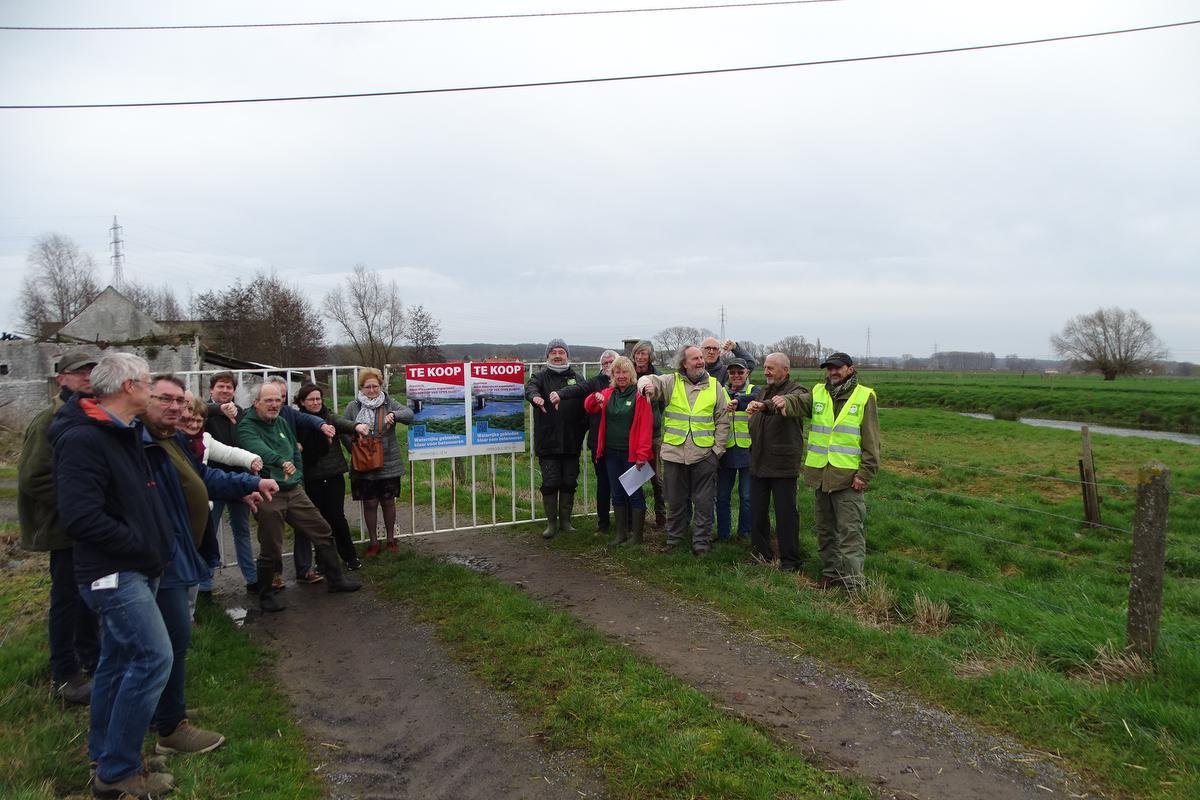Twenty people from Natuurpunt, Natuur.dome vzw and the West Flemish Environmental Union staged a protest in Anzegem on Tuesday morning against the possible expansion of the Anzegem Vijverdam Zuid industrial park.
The province of West Flanders currently designates 450 hectares of new industrial areas, of which 150 hectares are in South West Flanders, which is already the most paved area in the province. “This is a thorn in the side of Natuur.dome vzw and the West Flemish Environmental Union,” says Natuur.dome vzw president Kristina Naeyaert. “With a great poster campaign, we condemn the appropriation of wetlands and the opening of agricultural areas to industry, among other things.”
General inquiry
A public investigation by the province is currently underway to identify new research areas for industrial estates in the Waregem region. “Out of the fifty-hectare research area in the Waregem district, the county already wants to achieve 25.4 hectares. The research areas are divided into five sub-districts. They all have a known water problem, such as the Wiegwerdam Zuid (13.5 hectares) in Anzegem with its recent floods,” Naiert explained. In Manibeek and Maalbeek.In Deerlijk, the three areas identified are in a potential flood area for a creek: the Esser area (10.5 ha) on Slijpbeek, the Spijkerland area (11.6 ha) on Beverenbeek and the Nijverheidslaan area (13.7 ha) along the Wijmelbeek.The research area in Waregem, Schoendale (2.8 hectares), highly vulnerable to flooding.”
“Information from the county for public inquiry always states that extra attention should be given to water management at the site,” says Herman Nachtergaele of Natuur.dome. “This is considered a bottleneck, but building in water-sensitive areas today is simply irresponsible.”
“These areas are rare in our province,” says Bart VanWildmerich of the West Flemish Ecological Union. “They used to be called ‘water sick’ and useless for production, so they were drained or wetted. We know very well now that these areas are worth their weight in gold because they are needed to store rainwater and allow it to penetrate the soil. If we also stabilize these latter areas, we will also shut off the supply of water for the summer.
Both organizations rely, among other things, on the “Weerbaar Waterland” report, prepared by recognized water experts such as Professors Meire and Willems. “This report draws clear conclusions,” says Nachtergaele. There is an ongoing water crisis in Flanders, and its cause lies in far-reaching changes to the natural water system. One of the most problematic changes is continuity in concrete concrete. As a result, the water no longer penetrates into the soil and flows out much faster, with all the ensuing consequences. What we need to do – the report advises – for both water shortages and floods is to restore the water system. Thus, pouring the natural water reservoirs and then making up the space with an insulating basin would not be enough.”
Asks
The manner in which certain areas are declared suitable for further development also raises questions. “For a county, an area is suitable for development if a business park is already developed next to that area,” says Vanwildemeersch. “That’s quite a problematic approach because you already have business parks spread out all over that area. It would make many lands lawless, so the oil slick would expand further. Hof ter Schijn, an 18th-century farm house still embedded in the scenery Open naturalism, at risk of being completely removed.In addition to the historical heritage, small green elements will also disappear from our landscapes, which already carry the main tone of gray. Both unions also disagree with the plan’s compensation proposals. For example, the province proposes to abolish some areas designated as industrial zones and convert them into agricultural zones. According to the associations, a number of these are already partially occupied by buildings or so enclosed in a built-up area, for example Zone Zonnestraat and Heirbaan in Anzegem, Vaerestraat in Dentergem, that there is hardly any added value of restoration from the open space. This is confirmed by the conclusion of the consulting company Antea, which prepared the accompanying study. “There is no profit in terms of the environment and water management,” the activists say. The county relies on an ancient vision of landscape and water policy to still be able to open up these areas to industry. In the end, we will all pay the price for losing this space.”
Therefore, both organizations demand that space be freed first in poorly organized commercial complexes instead of carving out additional agricultural areas and green areas. Natuur.dome vzw and the West Flemish Environmental Confederation are therefore calling for a halt to this selection process for new industrial areas and a master plan to change water policy in West Flanders in accordance with the scientific evidence contained in the above-mentioned expert advice “Resilient Waterlands”. (GV)

“Total coffee specialist. Hardcore reader. Incurable music scholar. Web guru. Freelance troublemaker. Problem solver. Travel trailblazer.”






More Stories
The first Irish satellite to go into space
This startup wants to deliver anywhere in the world within an hour from space
Painless treatment by dental hygienists Oral Care Brilliant – Rotterdam Advertisement | The Havenlods